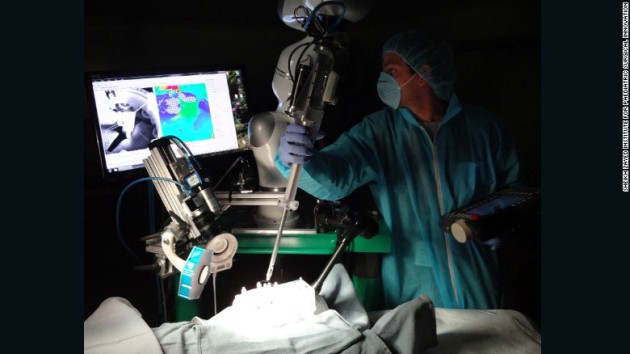Would you let a robot perform your surgery by itself?
 Meera Senthilingam / May 13: Robots have become the norm in numerous industries, taking over repetitive tasks that humans aren’t necessarily needed for — or want to do — such as the production of cars and electronics.
Meera Senthilingam / May 13: Robots have become the norm in numerous industries, taking over repetitive tasks that humans aren’t necessarily needed for — or want to do — such as the production of cars and electronics.
One step up the technological spectrum is artificial intelligence, where robots are now making informed decisions based on the tasks they’re presented with, highlighted by the burgeoning field of driverless cars.
As we get used to the idea of machines producing our goods, we’re slowly coming around to them making decisions for us, but would you put your life in their hands? More specifically, would you let a robot perform surgery on you?
Better than a Surgon
The idea might scare you, but scientists are making it happen — and doing it safely — as shown in a recent study by surgeons at Children’s National Medical Center in Washington.
The team showed for the first time that a supervised autonomous robot could perform soft-tissue surgery, stitching together a pig’s bowel during open surgery — and doing so better than a human surgeon.
“This smart, intelligent technology will tell you how to (conduct surgery) optimally,” said Peter Kim, associate surgeon in chief at the hospital and project lead on the Smart-Tissue Autonomous Robot, or STAR. “This is not to replace surgeons tomorrow but provide collective experiences of how things should be done.”
Kim argues that developing robots in this way can ensure all patients receive the best care, regardless of which surgeon is available when they are in need of it. “Wouldn’t it be nice that whenever or wherever you need surgery, it’s done by the best surgeon?”
Robot vs. human
The use of robots to aid with surgeries is nothing new. Surgeons regularly use devices such as the da Vinci Surgical System to perform complex procedures, and the robots can help access hard-to-reach tumors or visualize the inside of a patient with minimal invasion.
But the use of robots purely as aids is what Kim is trying to move beyond. He wants them to outdo the surgeons.
“(Current) tools are simple extensions of a human. Unless you make them better, there’s no point,” said Kim, who believes that his robot can be developed to conduct routine parts of a procedure, freeing up surgeons to focus on more challenging aspects. “The tool will come in at a time and place for maximal function.”
How does it work?
In the study, STAR sutured and reconnected bowel segments in a selection of pigs. Results were compared to those of manual surgery, the use of laparoscopes and use of robot assistance with the da Vinci system. On all counts, such as quality and accuracy, STAR came out shining bright.
The machine is made up of a robotic arm and surgical tools that use imaging technologies and markers to navigate along tissue. The visuals further help the robot decide where stitches should be made.
“The robot makes the decision of where sutures should go, based on vision and pressure,” Kim said. “The precision is within a sub-millimeter range.”
Robots are already used to work on hard tissues, such as bone, but the solid structure offers an easier, more stable target for the robot to cut into. Soft tissues are more challenging.
“Soft tissue constantly moves, so one major finding (of this) is that we can model soft tissue and follow it,” Kim said.
The team hopes that using robots autonomously will remove human error from the operating room for the 45,000 soft-tissue surgeries estimated to take place in the United States each year. A recent study suggested that medical mistakes might be the third leading cause of death in the country.
“With other robot technologies, complication rates haven’t changed at all,” Kim said. CNN
